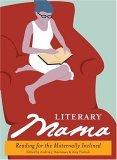I’m a little bit shy of 100 pages in to Kate Atkinson’s 1995 debut novel Behind the Scenes at the Museum, but from page one I was hooked. The protagonist launches herself at the reader with the declarative first two-word sentence, “I exist!” at the moment of her conception, and drags you with her as she gets to know her slightly twisted and eccentric British family.
Kate Atkinson can write. Oh, how I wish I could write like this! And it’s her first novel, which makes me unsure whether I want to admire her or dislike her for such a perfectly constructed and beautifully written story. Her prose reminds me of Margaret Atwood at her best, but without the overt intellectual challenge that Atwood’s work so often has. In fact, now that I think of it, she also reminds me a great deal of Alice Munro, except that her spin on magic realism is more satiristic realism. And speaking of powerful Canadian woman writers, there’s more than a passing resemblance to Carol Shields here, too. Hmmm, no wonder I like it so much.
Each chapter (so far) juxtaposes a year in the life of Ruby, the protagonist, with a”footnote” from her past, a clever device Atkinson uses to jump back and forth in time. The footnotes are almost as long as the chapters, and tell stories from Ruby’s maternal ancestors, so far through the first and second world wars. Although the footnotes are colourful and interesting, they’re not as enjoyable as the main narrative simply because they lack Ruby’s delightfully wry voice and insight. She describes her first lonely night outside the womb, in the maternity ward:
It’s very dark in the night nursery. Very dark and very quiet. A dim blue light shines in one corner, but most of the cots are just black coffin-like shapes. The darkness stretches out to infinity. Space winds whip through the icy interstellar spaces. If I reached out my tiny, wrinkled fingers that look like boiled shrimp, I would touch – nothing. And then more nothing. And after that? Nothing. I didn’t think it would be like this. It’s not that I expected a street party or anything – streamers, balloons, banners of welcome unfurling – a smile would have done.
My only complaint so far is that the book is packed so tightly with an excess of quirky characters in three different generations that I’m having trouble remembering who’s who. (This, admittedly, may be as much a problem with my inability to hold a thought in my head lately as with any fault in the narrative.) And while her writing is simply gorgeous, there is a grim brutality just beneath the surface in parts of the story that for some reason I am finding very unsettling. And yet again (she hedged), I admit that the grimness of some of the characters is compelling in itself. Ruby’s mother in particular, the chronically overwhelmed and underenthused (and unfortunately named) Bunty comes to mind as a character that I find profoundly unlikeable – but relentlessly interesting nonetheless.
One of the first books I reviewed was a later Kate Atkinson book, Case Histories, but I wasn’t nearly as fond of that book out of the gate as I am of this one. I think, in fact, this one may turn out to be one of my favourites. Highly recommended!

